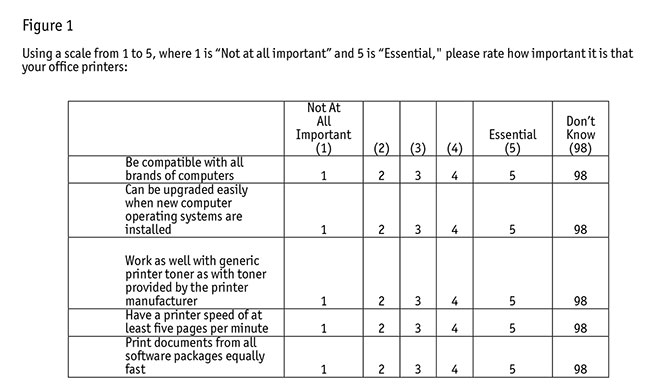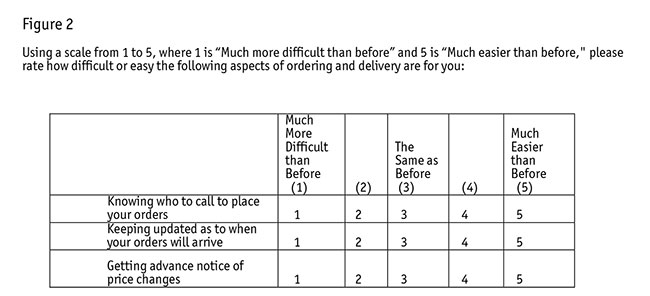Make it matter
Editor's note: Doug Berdie is president of Consumer Review Systems.
COVID-19 has had a profound effect on almost all phases of life. Marketing research is not exempt. B2B researchers on both the client side and the supplier side have felt the burdens of new challenges to obtaining quality research results necessary to guide sound decision-making.
High rates of employee turnover and staffing shortages, coupled with reduced discretionary time on the job to do things like complete surveys, mean that a precise focus on proven research tactics is needed to use B2B research effectively. B2B research (as well as consumer research) generally consists of five specific activities. Let’s review each of them with a particular emphasis on how they can be conducted successfully in these new and changing times.
Sample selection
One of the most difficult steps in B2B research is ascertaining which people have the information you wish to collect. Decisions affecting, for example, criteria used to purchase the products/services you provide could be totally made by upper management, totally made by people in the purchasing department, totally made by those who actually use the products/services of interest or made by some combination (varying for each client company) of those and other people.
And, with the high rate of absenteeism and turnover due to the pandemic, it’s even more challenging to identify which people occupy those positions. Hence, rather than just trying to contact people you’ve gone to before, it’s imperative to have the people in your organization who actually deal with those clients help you identify who, at that moment, has the information you want. These could be salespeople in your organization or people in other departments. The job titles of who best can identify who should be surveyed will vary from one company to another. It’s wise to have the person in your organization who deals with the targeted person verify with that person that they are still the one you should contact and let them know they will receive a contact. When your person does that verification, be sure they indicate the research will be very fast.
During these stressful times, I’d recommend a carefully selected sample of people and keeping the number surveyed to the minimum needed to receive reliable, stable data – rather than mass-mailing out huge numbers of surveys. Keeping sample sizes reasonable allows resources that would otherwise be used on overly large samples to be directed to the response rate-enhancing techniques described below. It’s axiomatic that high response rates from smaller samples (as long as they are large enough) yield better data than massive numbers of results from an unrepresentatively large, low response-rate sample.
Also, you may wish to consider two separate samples: 1) a sample from among your very best customers (i.e., those you most wish to retain); and 2) a sample from less-important customers (in terms of revenue) but who may have promising potential in terms of increased sales. That way, with a smaller overall sample, you’ll still be sure to get a good read on those two important segments.
Questionnaire/data collection design
Your objective should be to limit any questionnaires to the shortest possible length – as a way of acknowledging the times we live in. And, if there are some types of data you can obtain from means other than surveying, try to get them that way to help keep questionnaires as short as possible.
Most B2B research is interested in the following general types of topics:
- relative importance of criteria used to select type/brand of product (including availability, price relative to the past and competition, distinguishing features, past experience with supplier/product, etc.);
- relative importance of product/service usage characteristics;
- new product/service features that would be attractive.
Now, when people’s time is limited, it’s best to pare questions to only the most essential. The above outline could be transformed into three rating scales, all which could fit on one page, using a format such as shown in Figure 1.

And, if you wish, you could add one open-ended question at the end, something to the effect of: “Please describe any of your above ratings that are different than they would be if there were no COVID-19 situation.”
If you are trying to reach end-use consumers through your channel partners, you may wish to offer a variety of questionnaires tailored to specific needs those channel partners may have. For example, if you wish to survey auto dealer customers, a common-core set of a few questions, coupled with a couple the dealer can choose, will provide the most helpful feedback. For example, if a dealer has just overhauled the service bay, the dealer may want feedback on that, whereas other dealers may have some other area of special interest.
Also, given the pandemic situation and uncertainty about how long it may last, you may wish to ask a series of short questions (perhaps, on a one-time basis or even to just a subset of people) like those shown in Figure 2.

You could also add a simple open-ended question such as: “Please describe any actions you are finding effective for dealing with any changes you have indicated.”
Survey administration process
Given the COVID-19 situation, it’s nice to let recipients decide for themselves when it’s a convenient time to take a survey. Consider using a mail survey, with all the tactics that enhance response rate, such as:
- Survey and very short cover letter enclosed in a #10 business envelope that has the recipient’s name individually typed on the envelope and that uses an actual postage stamp (if a commemorative stamp exists celebrating the topic of your survey content, use that);
- Postage paid #9 return envelope – again, with a real postage stamp affixed to it (as opposed to metered or business-reply postage);
- A mail follow-up reminder sent five to seven days after the original mailing. If you can do something fun (or funny) with the follow-up, it’s likely to enhance response rate. And, of course, another #9 envelope should be enclosed with the follow-up, with an actual postage stamp on it.
If you have the intended recipient’s home address, sending the materials to that address may be more effective than sending them to the work address, especially given how many people are currently working from home. It’s rare enough these days to receive something in the mail at home that trying that approach may increase interest in opening the envelope. It also lets recipients complete the easy task at their leisure.
Data analysis
Given the shorter questionnaires and limited sample sizes needed these days, complex and time-consuming multivariate analyses will likely neither be possible nor helpful. Hence, rather straightforward descriptive analyses should be considered which, also, allow for faster feedback to management to facilitate timely decisions about improvements to make.
B2B post-survey follow-up
A best practice is to send those who responded to your survey a follow-up thank-you. And, it’s also a good idea to send a subsequent follow-up letting them know of the specific actions you will be taking based on the survey feedback and how they can expect to benefit from those actions.
Keys to success
B2B marketing research is challenging even in the best of times. However, with the personnel turnover, limited discretionary time and more people working remotely (all resulting from COVID-19), the challenges are even more formidable. The keys to success will be 1) making it as quick and easy as possible for people to participate; and 2) limiting the content of the research to only what’s most important for you to learn while also showing respondents that you intend to act in ways that will benefit them.
